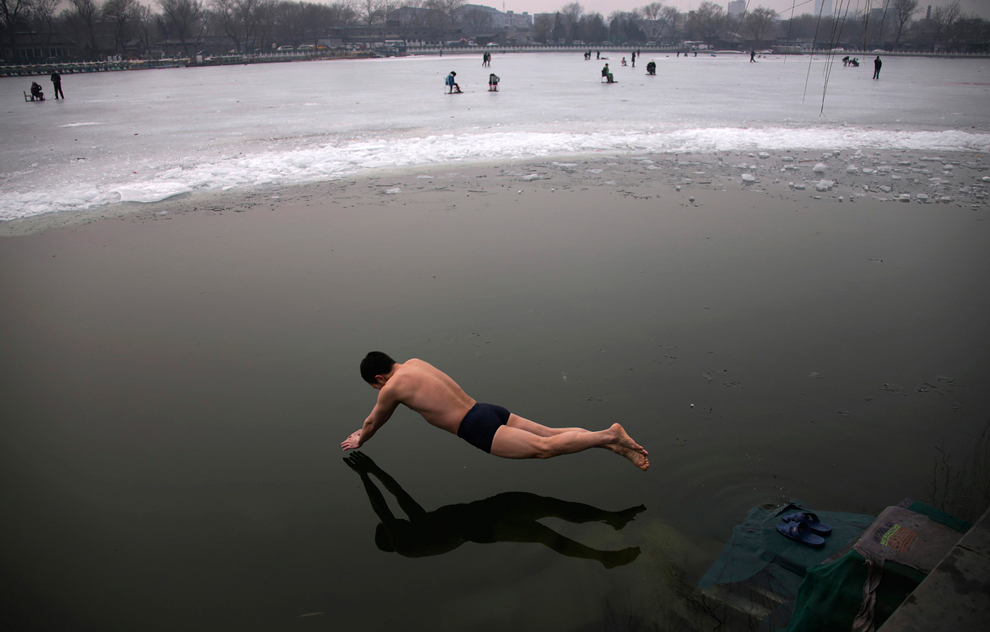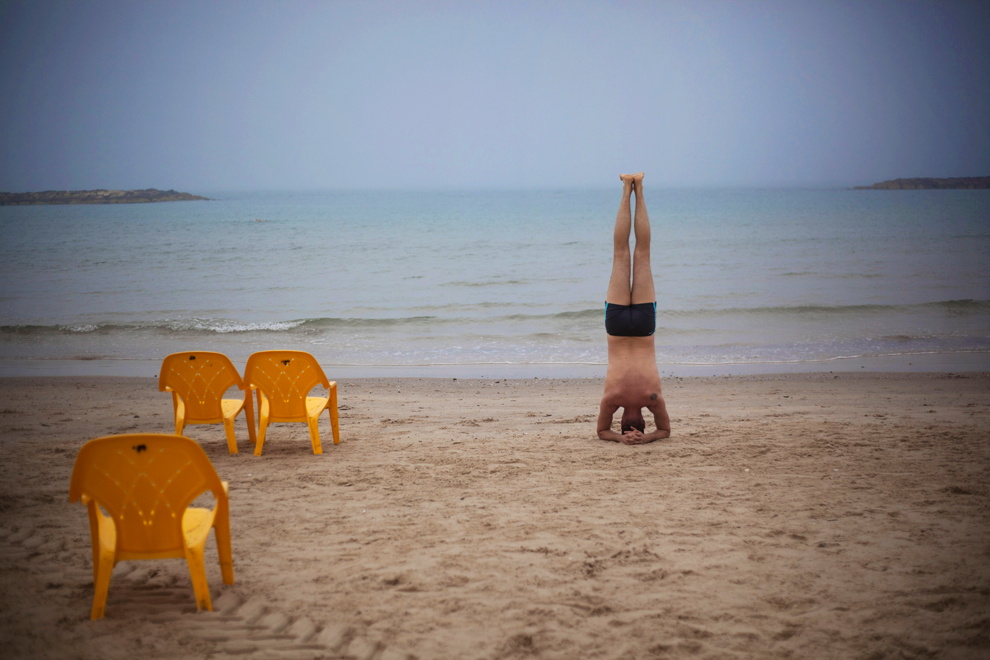It would seem that photography could not have a theory of anything: a theorem is a proposition or set of propositions that can explain a process, while a photograph is not a proposition at all and records only a single place in a single moment of time. Theorems can be proved to be true or false, and if true they account for some pattern, relationship, or regularity that can occur more than once. Photographs always show what they show, even if faked, and they are tethered to particularity. The image below is not a theory of diving or swimming or falling bodies or winter rituals or anything else; it is a photograph of a man diving into a lake on a winter’s day.
Unless, that is, you want to actually think about what is in front of your eyes. This remarkable image has captured something essential about the nature of action. Whether defined as intentional motion, conduct to achieve a result, performance of a function, military encounter, or legal initiative, action involves throwing oneself forward into a space that is both known and unknown. There is prior deliberation, the decision to act, the action, the experience that ensues, and the result, and all can be occur in a single rush of consciousness–something like entering the water of a winter lake.
Photography stops time to reveal each separate moment in the logical unfolding of an action. Here the man is caught in to sheer act of acting: of throwing himself forward, suspended between past and future—between the prior time that led to this bold, decisive point from which there is no turning back, and the moment when consequences will suddenly, irrevocably exist.
As with the man’s silhouette, this sheer act is mirrored by the serenity of the smooth surface of the water, with just the faintest ripple of his leap beginning to show. The calm surface will cease to exist in an instant, but in this moment it is a mirror that reveals not only the ephemeral nature of the act itself, but also the ability of the camera to create a silhouette above the water, and one that lasts long after the act itself have disappeared.
Of course, the man leaps to enter the water, and so the first image shows us something about to happen. This second photograph is remarkable not because of the amazing physical skill of the man on the beach, but because of how it uses his yogic power to expose action in the moment that it is happening. Paradoxically, his immobility shows us the soul of intentional motion: instead of being merely a falling body, he arrests motion to demonstrate bodily control. The contrast with the beach chairs makes the point all the more clear. They can stand there much longer than he can hold his position, but that is all they can do and they can’t even decide to do that. They are inert matter, while he is the demonstration of embodied spirit. Natural forces suffuse the scene, but his repose demonstrates a unique capability for action that is more than any natural force.
The photograph also works paradoxically: it’s ability to freeze movement seems unnecessary, as he will be almost perfectly immobile, but the ability of the camera is mirrored by his action, and so we are more than usually aware of how the moment of action can be extended, how long it can seem from within, how much concentration and effort can be present within what seems to be all flow.
This next photo takes us to what follows: the instant through which what is happening includes something unhappening. The man is acting, moving forward, and although he seems to be surging through the fourth wall into our space, the camera has caught what is only a relatively routine activity. He acts by rowing a boat on the Ganges, but the marvelous, world changing reality of action is revealed by the birds exploding off the water. They may be just reacting, but in doing so they and he together reveal the charismatic property of action. It undoes whatever stasis that was, creating a second burst of energy. He could be an eternal figure, but not Charon on the river Styx; no, he reveals how acting is a simultaneous making and unmaking of the world. Like the diver, he moves into what is both known and unknown, but now we are more aware of how changes lie behind him as much as they are in the future.
And so we get to the last photo or a protester kicking in the glass of a commercial building in Barcelona, Spain. This photo exposes everything at once by capturing a moment of perfect equipoise from which ferocious energies are being released. This is the world shattering moment when the actor is both exploding into the future and being thrown back into the past. This act of force acquires a multiplying factor, for action and reaction are perfectly paired processes, much like the protestor and his mirror image, joined at the point of impact and already falling away in opposite directions. There was an ordered world, and then this moment of radical change, and then everything will continue to fall forward and backwards, into continual change not yet foreseen and past circumstances that may change very little except to be forgotten.
Photography is a medium that documents people acting and being acted upon. The action itself often can be taken for granted while attention rightly turns to its motives or effects. But action itself is a profound form of being in the world. It may not be limited to human beings, but it defines them nonetheless. Understanding action remains an unfinished task for philosophy, but it also might benefit from paying more attention to photography.
Photographs by Petar Kujundzic/Reuters, Ariel Schalit/Associated Press, Zach Gibson, Juanfra Alvarez. Gibson and Alvarez are the first two photographers featured in an excellent Big Picture exhibition of Photojournalists Under 25.




awesome…..do follow the link
[…] Download Image More @ http://www.nocaptionneeded.com […]